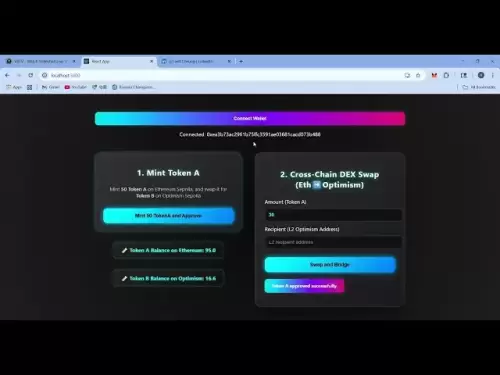-
 Bitcoin
Bitcoin $109,459.7682
2.44% -
 Ethereum
Ethereum $2,598.6052
6.29% -
 Tether USDt
Tether USDt $1.0003
0.00% -
 XRP
XRP $2.2734
3.95% -
 BNB
BNB $661.4886
1.58% -
 Solana
Solana $155.4825
4.35% -
 USDC
USDC $0.9999
-0.02% -
 TRON
TRON $0.2838
1.04% -
 Dogecoin
Dogecoin $0.1740
8.25% -
 Cardano
Cardano $0.6047
9.04% -
 Hyperliquid
Hyperliquid $40.2302
6.50% -
 Sui
Sui $2.9863
10.05% -
 Bitcoin Cash
Bitcoin Cash $509.5786
0.60% -
 Chainlink
Chainlink $13.8156
6.03% -
 UNUS SED LEO
UNUS SED LEO $9.0142
0.69% -
 Avalanche
Avalanche $19.0337
8.68% -
 Stellar
Stellar $0.2438
5.17% -
 Toncoin
Toncoin $2.9012
3.59% -
 Shiba Inu
Shiba Inu $0.0...01210
6.20% -
 Litecoin
Litecoin $90.0882
7.05% -
 Hedera
Hedera $0.1597
8.53% -
 Monero
Monero $326.3340
2.88% -
 Polkadot
Polkadot $3.6365
9.32% -
 Bitget Token
Bitget Token $4.6162
2.72% -
 Dai
Dai $1.0001
0.00% -
 Ethena USDe
Ethena USDe $1.0002
-0.01% -
 Uniswap
Uniswap $7.6403
10.47% -
 Pepe
Pepe $0.0...01060
12.03% -
 Aave
Aave $281.3664
7.56% -
 Pi
Pi $0.4992
1.76%
What does Bitget leverage trading mean
Leverage trading on Bitget allows traders to amplify potential profits, but it also magnifies risks like margin calls and liquidation, necessitating a thorough understanding of its mechanics and calculated use.
Nov 19, 2024 at 11:16 am

What Does Bitget Leverage Trading Mean?
Leverage trading is a trading technique that allows traders to borrow funds from a broker to increase their trading position. This can be a powerful tool for increasing profits, but it also comes with increased risk.
In the world of cryptocurrency trading, leverage trading is offered by many exchanges, including Bitget. Bitget offers leverage of up to 100x on some trading pairs, which means that traders can borrow up to 100 times their initial investment.
How Does Leverage Trading Work?
Leverage trading works by allowing traders to borrow funds from a broker to increase their trading position. This means that traders can trade with more money than they actually have, which can lead to increased profits. However, it also comes with increased risk.
For example, if a trader has $100 in their account and they use 10x leverage, they can trade with $1,000. If the price of the asset they are trading goes up by 10%, they will make a profit of $100. However, if the price of the asset goes down by 10%, they will lose $100.
The Benefits of Leverage Trading
There are several benefits to using leverage trading, including:
- Increased profits: Leverage trading can help traders to increase their profits by allowing them to trade with more money than they actually have.
- Reduced risk: Leverage trading can also help to reduce risk by allowing traders to limit their losses to the amount of their initial investment.
- Flexibility: Leverage trading provides traders with more flexibility by allowing them to trade with different amounts of leverage.
The Risks of Leverage Trading
However, there are also several risks associated with leverage trading, including:
- Increased losses: Leverage trading can also lead to increased losses if the price of the asset being traded goes against the trader.
- Margin calls: If the price of the asset being traded goes against the trader and their losses exceed their initial investment, they may receive a margin call from their broker. This means that they will need to deposit more funds into their account or close their position.
- Liquidation: if the price of the asset being traded goes against the trader and their losses exceed their initial investment plus any additional funds they have deposited, their position may be liquidated. This means that they will lose all of their investment.
How to Use Leverage Trading
If you are considering using leverage trading, it is important to understand the risks involved. You should also make sure that you have a trading plan and that you are using leverage in a way that is appropriate for your risk tolerance.
Here are some steps you should follow:
- Choose the Right Exchange: First, you need to choose a cryptocurrency exchange that offers leverage trading. Not all exchanges offer this feature, so it's important to do your research. Once you've chosen an exchange, you'll need to create an account and deposit funds.
- Open a Trading Account: Once you have opened an account, you will need to open a trading account. This is where you will store your funds and place your trades.
- Fund Your Account: The next step is to fund your account. You can do this by depositing cryptocurrency or fiat currency.
- Choose a Trading Pair: Once you have funded your account, you need to choose a trading pair. This is the pair of cryptocurrencies that you will be trading.
- Set Your Leverage: Once you have chosen a trading pair, you need to set your leverage. This is the amount of money that you will borrow from the broker.
- Place Your Trade: Once you have set your leverage, you can place your trade. You can either buy or sell the asset.
- Manage Your Risk: Once you have placed your trade, you need to manage your risk. This means setting stop-loss orders and taking profits.
- Close Your Trade: Once you have reached your profit target or stop-loss order, you can close your trade.
Disclaimer:info@kdj.com
The information provided is not trading advice. kdj.com does not assume any responsibility for any investments made based on the information provided in this article. Cryptocurrencies are highly volatile and it is highly recommended that you invest with caution after thorough research!
If you believe that the content used on this website infringes your copyright, please contact us immediately (info@kdj.com) and we will delete it promptly.
- Crypto Summer Buys: Is Shiba Inu Out, and What's In?
- 2025-07-03 18:30:12
- Bitcoin, Solaris Presale, and Coin Watch: Catching the Next Wave
- 2025-07-03 19:10:11
- BONK ETF Buzz: Catalyst for a Meme Coin Moonshot?
- 2025-07-03 19:50:12
- Sui Coin, Bitcoin Solaris, and the Presale Opportunity: Catching the Next Wave
- 2025-07-03 19:50:12
- Sui Coin, Bitcoin Solaris, and Presale Opportunities: What's the Buzz?
- 2025-07-03 19:55:14
- MEXC's Bitcoin Reserves: A Fortress of Asset Coverage
- 2025-07-03 19:55:14
Related knowledge

How to identify the contract value range in combination with the market profile?
Jul 02,2025 at 10:56pm
Understanding the Market ProfileTo effectively identify the contract value range in combination with the market profile, it's essential to first understand what each concept entails. The market profile is a framework that helps traders visualize how price and time interact across a given period, typically a trading day or session. It provides insights i...

How to use the price slope to filter the false breakthrough signal of the contract?
Jun 20,2025 at 06:56pm
Understanding the Concept of Price Slope in Contract TradingIn contract trading, especially within cryptocurrency derivatives markets, price slope refers to the rate at which the price changes over a specific time period. It helps traders assess the strength and sustainability of a trend. A steep slope may indicate strong momentum, while a shallow slope...

How to determine the expected volatility of the contract through the volatility cone?
Jun 19,2025 at 12:28pm
Understanding the Basics of Volatility in Cryptocurrency ContractsIn the realm of cryptocurrency trading, volatility is a key metric that traders use to assess potential risk and reward. When dealing with futures contracts, understanding how volatile an asset might become over time is crucial for position sizing, risk management, and strategy developmen...

How to formulate a contract intraday trading plan in combination with the pivot point system?
Jun 21,2025 at 03:42pm
Understanding the Basics of Pivot Points in Cryptocurrency TradingPivot points are technical analysis tools used by traders to identify potential support and resistance levels. These levels are calculated using the previous day's high, low, and closing prices. In the context of cryptocurrency trading, where markets operate 24/7, pivot points help trader...

How to adjust the contract position ratio through the price fluctuation entropy?
Jun 22,2025 at 11:42am
Understanding Price Fluctuation Entropy in Cryptocurrency ContractsIn the world of cryptocurrency futures trading, price fluctuation entropy is a relatively new concept used to measure market volatility and uncertainty. It derives from information theory, where entropy refers to the degree of randomness or unpredictability in a system. In crypto contrac...

How to use the volume swing indicator to predict the contract volume-price divergence?
Jun 18,2025 at 11:42pm
Understanding the Volume Swing IndicatorThe volume swing indicator is a technical analysis tool used primarily in cryptocurrency trading to evaluate changes in volume over time. Unlike price-based indicators, this metric focuses solely on trading volume, which can provide early signals about potential market reversals or continuations. The key idea behi...

How to identify the contract value range in combination with the market profile?
Jul 02,2025 at 10:56pm
Understanding the Market ProfileTo effectively identify the contract value range in combination with the market profile, it's essential to first understand what each concept entails. The market profile is a framework that helps traders visualize how price and time interact across a given period, typically a trading day or session. It provides insights i...

How to use the price slope to filter the false breakthrough signal of the contract?
Jun 20,2025 at 06:56pm
Understanding the Concept of Price Slope in Contract TradingIn contract trading, especially within cryptocurrency derivatives markets, price slope refers to the rate at which the price changes over a specific time period. It helps traders assess the strength and sustainability of a trend. A steep slope may indicate strong momentum, while a shallow slope...

How to determine the expected volatility of the contract through the volatility cone?
Jun 19,2025 at 12:28pm
Understanding the Basics of Volatility in Cryptocurrency ContractsIn the realm of cryptocurrency trading, volatility is a key metric that traders use to assess potential risk and reward. When dealing with futures contracts, understanding how volatile an asset might become over time is crucial for position sizing, risk management, and strategy developmen...

How to formulate a contract intraday trading plan in combination with the pivot point system?
Jun 21,2025 at 03:42pm
Understanding the Basics of Pivot Points in Cryptocurrency TradingPivot points are technical analysis tools used by traders to identify potential support and resistance levels. These levels are calculated using the previous day's high, low, and closing prices. In the context of cryptocurrency trading, where markets operate 24/7, pivot points help trader...

How to adjust the contract position ratio through the price fluctuation entropy?
Jun 22,2025 at 11:42am
Understanding Price Fluctuation Entropy in Cryptocurrency ContractsIn the world of cryptocurrency futures trading, price fluctuation entropy is a relatively new concept used to measure market volatility and uncertainty. It derives from information theory, where entropy refers to the degree of randomness or unpredictability in a system. In crypto contrac...

How to use the volume swing indicator to predict the contract volume-price divergence?
Jun 18,2025 at 11:42pm
Understanding the Volume Swing IndicatorThe volume swing indicator is a technical analysis tool used primarily in cryptocurrency trading to evaluate changes in volume over time. Unlike price-based indicators, this metric focuses solely on trading volume, which can provide early signals about potential market reversals or continuations. The key idea behi...
See all articles

























































































